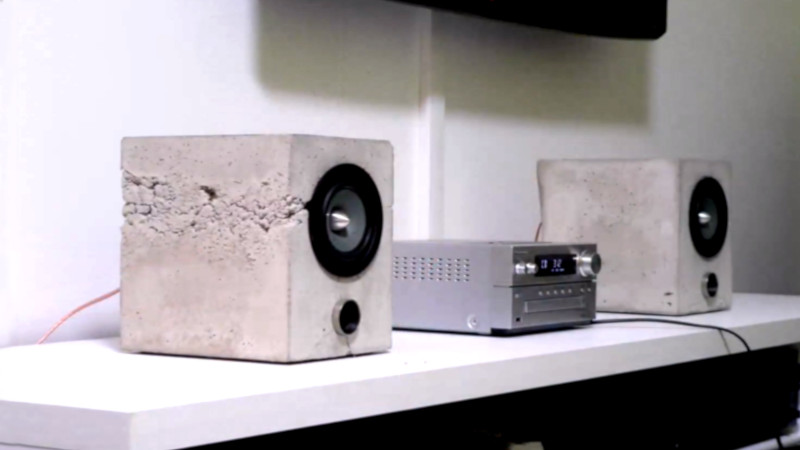Concrete is great if you feel like making something heavy on the cheap. [Marek Unger] decided to have a go, using the material to cast speaker cabinets for a home hi-fi rig (Youtube link, embedded below).
Initial attempts involved creating a laser-cut MDF outer mold, with a styrofoam core inside to be removed later. This was unsuccessful, and [Marek] developed the design further. The second revision used an inner core also made from lasercut MDF, designed to be left inside after casting. This inner mold already includes the mounting holes for the speaker drivers, making assembly easier too.
Once cast, the enclosures were fitted with Tang-Band W4-1320SIF drivers. These are a full-range driver, meaning they can be used without needing crossovers or other speakers to fill in the frequency range. Each cabinet weighs just over 10kg, and they’re ported for extra response in the lower frequency bands. Sound tests are impressive, and the rough-finished aesthetic of the final product looks great in [Marek]’s living room.
We’ve seen concrete used for all manner of projects, from furnaces to USB hubs. Video after the break.















Check out Modustrial Maker for some great concrete tutorials.
Lotta air bubbles in the concrete mix, sand only would have been better. The worst shape for a speaker enclosure is a cube or sphere. There is only one matched big set of standing waves. Why copy flat design when you have a fluid medium? Leaving particle board inside makes the volume inside smaller, and screwing into it’s edge without inserts will fail.
Curious as to what the efficiency rating is.
High, no resonance of the enclosure. My father is now 80 years young and told me once he had seen a speaker with concrete enclosure at a school fancy fair when he was really young :) and that it sounded great for that time.
Later on, he made his own speakers with KEF drivers and the bass enclosure was double with sand in between, also to eliminate resonance.
When pouring concrete, it is common practice to use a vibrating needle (aka poker) to get the air bubbles out while the concrete mixture is still wet. The surface after removing the formwork looks better, as well as being structurally stronger than the concrete / air mixture you get when not doing that, as shown in the pictures in this article :)
Here is an engine that drives the poker so it vibrates: https://www.coastalhire.co.za/product/tm-drive-unit-gx160
and here are some pokers: https://www.coastalhire.co.za/product/26mm-36mm-48mm-60mm-or-75mm-poker
On smaller forms (molds) like this it’s pretty common to smack the outside with a hammer as you slowly fill it, pausing occasionally to ram the mix in with a wooden poker to fill in the voids. Helps to get a very smooth finish on the surface because it drives the aggregate (rocks) in deeper away from the surface being hit.
Full production usually has a shaker table going, but I’ve seen them smack the outside with a hammer too.
Yea – a shaker table would be perfect for this
..and again, sound is evaluated by listening them on youtube..
1. Recording microphone
2. Youtube’s sound processing
3. You listened with your own speakers/headphones
..why am I even trying to explain this.
By who? I don’t see anyone doing that, neither here nor in the YouTube comments.
He’s saying that WE the viewer (and the editor) cannot make any judgements about how these speakers sound because we can’t hear them directly. Which is true… But kinda misses the point of showing off how it was made. I guess the author could have left out, “Sound tests are impressive”, but I took that as a summary of the makers judgement, not the authors.
I like the idea and might do one. But this would be a horn that I have in wood now to hear the difference. I do have an issue though with the sound if it comes from this box – low fequency is too soft – so I assume the hole and the size are not well tuned to the speaker. Or it might just be music from somewhere.
Because you’re determined to try and save idiots from their mistakes, or
you really like banging your head against the wall.
Both?
Bass-reflex is a lie. It enhances speakers’ bandwidth at the lower and but makes the impulse response less sharp due to excessive phase shift. Marek replaces one phase shifting filter (cross-over) with another (bass reflex). It doesn’t make much sense.
Although the drivers are advertised as full-range, they are more like 2/3 full. Their performance below 100Hz is less then perfect (which is fine for 4″ drivers).
Full-range drivers make sense as a replacement for mid- and high-range drivers. Without a cross-over between 1-5 kHz, and hence, without phase distortions information about sound location (carried by phase differences between the channels) is not lost.
Wonder if sooner or later it will develop a rattle between the inner wooden case and the concrete shell. I.e. when the wood dries, shrinks a little and thus detaches from the concrete.
Better loading and bass from a folded horn, which can also be built in concrete …
http://lowtherloudspeakers.com/html/products.html
A good friend of mine did some concrete speakers for his final exam in his engineering/design college. Those were real beasts. I think more than 100pounds each. He used carbon/glass fiber reinforced concrete and a specially made thermally controlled vacuum/vibration rig. I remember A LOT of night-shifts to get it done in time. Tannoy coaxial drivers were used iirc.
And how did they sound?